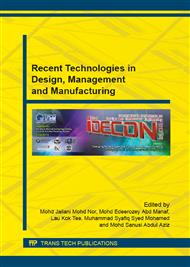p.245
p.250
p.257
p.262
p.267
p.273
p.277
p.282
p.287
Investigating and Modeling the Machinability of Al 6061 Using Response Surface Methodology
Abstract:
Decreasing the effect of temperature, surface roughness and vibration amplitude during turning process will improve machinability. Mathematical model has been developed to predict responses of the surface roughness, temperature and vibration in relation to machining parameters such as the cutting speed, feed rate, and depth of cut. The Box-Behnken First order and second-order response surface methodology was employed to create a mathematical model, and the adequacy of the model was verified using analysis of variance. The experiments were conducted on aluminium 6061 by cemented carbide. The direct and interaction effect of the machining parameters with responses were analyzed. It was found that the feed rate, cutting speed, and depth of cut played a major role on the responses, such as the surface roughness and temperature when machining mild steel AISI 1018. This analysis helped to select the process parameters to improve machinability, which reduces cost and time of the turning process.
Info:
Periodical:
Pages:
267-272
Citation:
Online since:
May 2015
Authors:
Price:
Сopyright:
© 2015 Trans Tech Publications Ltd. All Rights Reserved
Share:
Citation:


